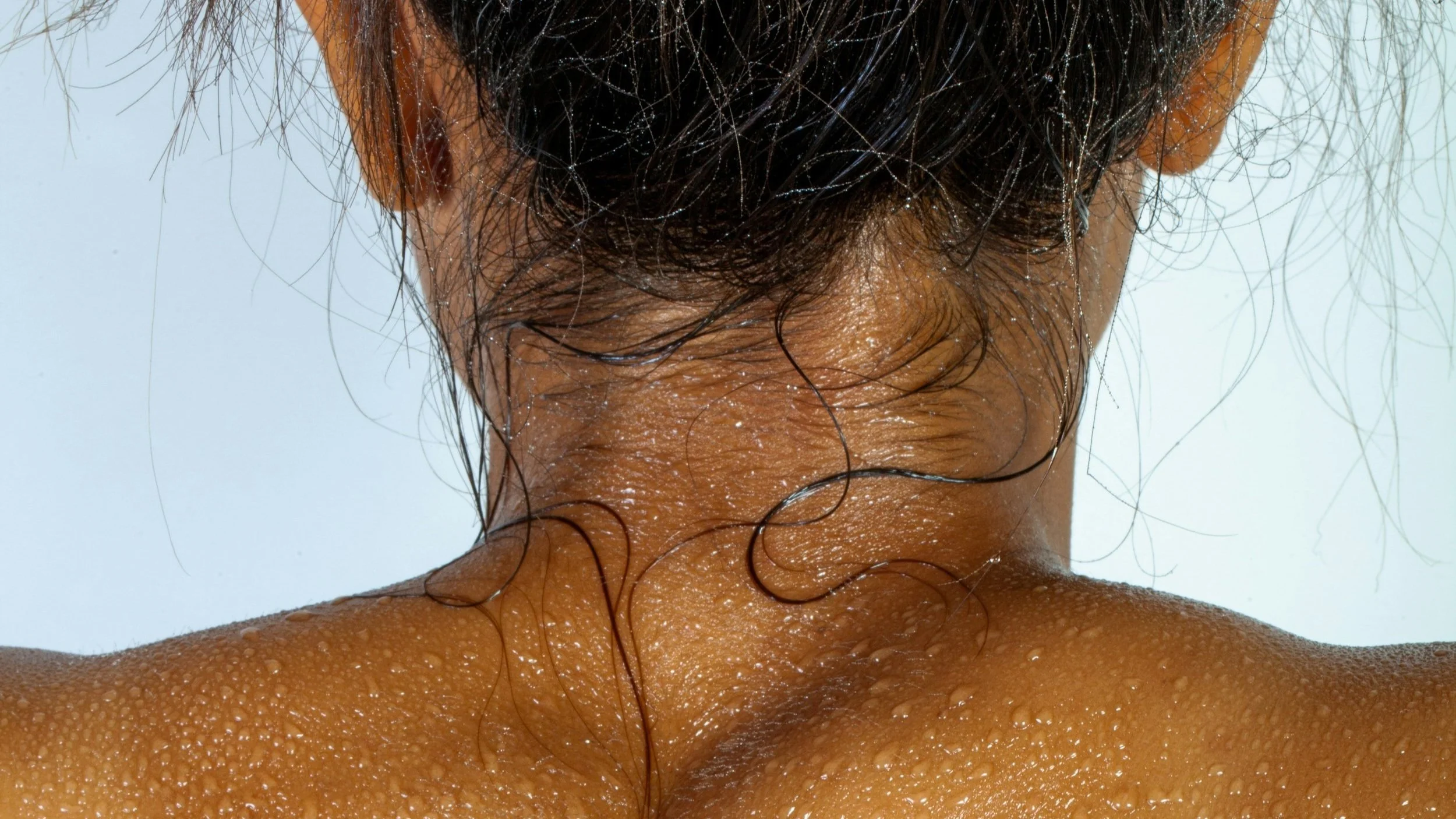Soothe the Sizzle: Your Essential Food Guide to Managing Hot Flushes & Night Sweats (Part 1)
Alright, ladies, let's talk about the sometimes-fiery reality of hot flushes and night sweats. One moment you're perfectly comfortable, the next you're experiencing an intense wave of heat. And then there are those nights, waking up feeling clammy and overheated. If you're navigating the journey of menopause, these experiences are likely all too familiar. Over half of our Hello Mimi community report hot flushes and night sweats as two of their most frustrating symptoms during menopause. And while HRT and cooling pillows have their place, what you eat can be one of the most powerful tools in your symptom-soothing toolbox.
This isn't about restrictive diets; it's about empowering yourself with knowledge about which foods can genuinely support your body. We're going to explore science-backed nutritional strategies that can help dial down the internal heat, allowing you to reclaim your comfort, both day and night.
Understanding the Internal Thermostat: Why Food Matters
Before we dive into the delicious details, let's briefly touch on why your diet impacts hot flushes and night sweats. Menopause is characterized by fluctuating hormone levels, particularly estrogen. These hormonal shifts can disrupt the hypothalamus, the part of your brain that acts as your body's thermostat. When this delicate balance is off, your body can misinterpret normal temperature changes as overheating, triggering a hot flash.
What you consume directly influences your hormonal balance, inflammation levels, blood sugar regulation, and even your gut microbiome – all of which play a role in the intensity and frequency of your symptoms. By making conscious food choices, you can create an internal environment that is less prone to these uncomfortable surges.
The Power Players: Foods to Embrace for Cooler Days & Nights
Let's get to the good stuff! Here are the dietary heroes that deserve a starring role in your anti-hot flash strategy:
1. Phytoestrogen-Rich Foods: Nature's Gentle Hormone Helpers
Phytoestrogens are plant compounds that can mimic estrogen in the body, albeit in a weaker form. They can gently bind to estrogen receptors, potentially helping to balance hormonal fluctuations.
*Soy Products: Edamame, tofu, tempeh, and miso are excellent sources of isoflavones, a type of phytoestrogen. Research suggests that regular consumption of soy can reduce the frequency and severity of hot flushes in some women. Opt for fermented, organic soy products when possible.
Flaxseeds: These tiny powerhouses are rich in lignans, another potent phytoestrogen. It's best to grind them fresh, if you can, to maximize absorption; sprinkle them on yogurt, oatmeal, or salads.
Legumes: Lentils, chickpeas, and beans also contain phytoestrogens and are excellent sources of fiber and plant-based protein.
Cruciferous Vegetables: Broccoli, cauliflower, Brussels sprouts, and kale contain compounds that support healthy estrogen metabolism.
* Please note: For some individuals, soy consumption can lead to allergic reactions (like hives or breathing difficulties) or mild digestive issues (such as bloating or nausea), may interact with certain medications, and its phytoestrogen effects can vary significantly from person to person due to individual sensitivities.
2. Omega-3 Fatty Acids: The Anti-Inflammatory Champions
Chronic inflammation can exacerbate hot flushes. Omega-3 fatty acids are renowned for their powerful anti-inflammatory properties, helping to calm your system.
Fatty Fish: Salmon, mackerel, sardines, and trout are rich in EPA and DHA, crucial omega-3s. Aim for two to three servings per week.
Chia Seeds & Walnuts: Excellent plant-based sources of ALA, another type of omega-3, which the body can convert into EPA and DHA.
3. Fiber-Rich Foods: Supporting Gut Health & Hormone Balance
A healthy gut is essential for overall well-being, including hormone regulation. Fiber promotes a healthy gut microbiome, aids in the elimination of excess hormones, and helps stabilize blood sugar.
Whole Grains: Oats, quinoa, brown rice, and whole-wheat bread provide complex carbohydrates and a steady release of energy, preventing blood sugar spikes that can trigger hot flushes.
Fruits & Vegetables: All varieties are packed with fiber, vitamins, and antioxidants. Prioritize a diverse range of colors to ensure a broad spectrum of nutrients.
Nuts & Seeds: Almonds, cashews, sunflower seeds, and pumpkin seeds are not only good sources of fiber but also provide healthy fats and essential minerals.
4. Hydration: Your Essential Coolant
Often overlooked, adequate hydration is crucial. Dehydration can worsen hot flushes and make you feel generally more uncomfortable.
Water: The purest form of hydration. Aim for at least 8 glasses a day, and more if you're active or it's a hot day.
Herbal Teas: Cooling teas like peppermint or spearmint can be particularly soothing.
The Culprits: Foods to Limit or Avoid
Just as some foods can help, others can intensify your symptoms. Minimizing or avoiding these can significantly reduce your hot flushes and night sweats:
1. Spicy Foods: While delicious, capsaicin in chili peppers can trigger a sudden dilation of blood vessels, mimicking a hot flash. If you're struggling, consider temporarily reducing your intake of very spicy dishes.
2. Caffeine: That morning coffee might give you a jolt, but it can also act as a vasodilator, widening blood vessels and potentially triggering a hot flash. Experiment with reducing your intake or switching to decaffeinated options.
3. Alcohol: Alcohol, particularly red wine, can cause blood vessels to dilate and raise core body temperature, leading to flushing and increased hot flushes. Consider reducing or eliminating alcohol, especially in the evening if night sweats are a concern.
4. Sugary Foods & Refined Carbohydrates: These cause rapid spikes and crashes in blood sugar, which can disrupt hormonal balance and contribute to hot flushes. Opt for natural sweeteners in moderation and prioritize whole, unprocessed foods.
5. Processed Foods & Trans Fats: These are often pro-inflammatory and lack essential nutrients, potentially putting additional stress on your body. Focus on fresh, whole ingredients whenever possible.
Beyond the Plate: Complementary Lifestyle Factors
While diet is a cornerstone, remember that it's part of a larger picture. Complement your food choices with these lifestyle adjustments:
Regular Exercise: Helps regulate hormones, reduce stress, and improve sleep quality.
Stress Management: Practice mindfulness, meditation, yoga, or deep breathing to calm your nervous system.
Adequate Sleep: Prioritize 7-9 hours of quality sleep to support hormonal balance.
Dress in Layers: Opt for natural, breathable fabrics like cotton to easily adjust to temperature changes.
Keep Your Environment Cool: Use fans, open windows, and keep your bedroom cool at night.
Ready to put these dietary principles into practice?
Dive into our companion blog post, "Crafting Your Personalised Anti-Hot Flash Menu: Delicious Recipes for Cooler Days & Nights (Part 2)," for delicious recipe ideas and practical tips to build your joint-friendly meal plan!
The Takeaway
Hot flushes and night sweats can be incredibly disruptive, but you have more control than you might think. By embracing a diet rich in phytoestrogens, omega-3s, and fiber, while thoughtfully limiting common triggers, you can significantly reduce their frequency and intensity. This isn't just about managing symptoms; it's about nourishing your body, empowering yourself with knowledge, and embracing a more comfortable and vibrant menopausal journey. Start today, one delicious, cooling bite at a time.
Ready to Feel a Bit More Like You Again?
If hot flushes and night sweats are just part of the picture and you’re also navigating things like bloating, mood swings, fatigue, or brain fog, we’ve got something that can help.
Our free 7 Days to Healthier Hormones Guide is a gentle, practical starting point to help you rebalance your body and feel more in control of your symptoms no matter what stage of menopause you’re in.
Inside, you’ll find:
A simple step-by-step hormone-supportive meal plan
Delicious recipes that fuel you without fuss
Daily tips to reduce inflammation, ease stress, and support detox naturally
It’s like a warm hug for your hormones and it’s totally free.
Download your copy here: 7 Days to Healthier Hormones Food Guide
Because you don’t need to do menopause on willpower alone. Let’s make it a little easier and a lot more nourishing.
Disclaimer:
At Hello Mimi, we’re here to support and empower you with education, encouragement, and practical tools but we’re not a substitute for personalised medical advice. The information in this blog is for general guidance only. Always consult a qualified healthcare provider before making changes to your health, diet, or supplements especially if you're managing a condition or taking medication.

